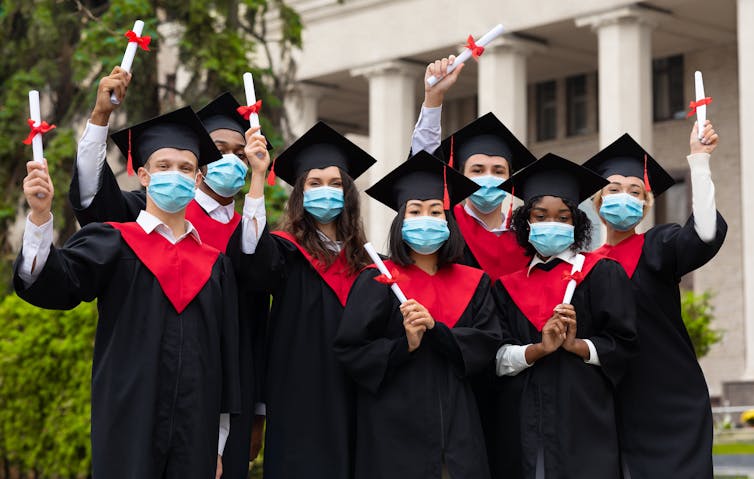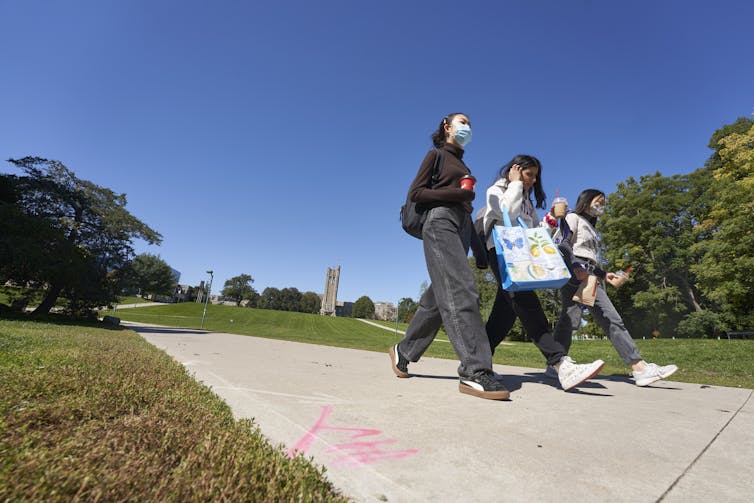Grade 12 university-bound grads: Orientation will help you in one of the biggest transitions of your lives

Universities continue to make huge changes to welcome incoming students and help them build social and mentoring connections while easing into their new lives. (Shutterstock)
BY Gerald Tembrevilla; Andre Phillion and Melec Zeadin
June 22, 2021
Finishing high school and starting university is a huge leap for anyone. It can be daunting, especially when it’s hard to see what lies on the other side of the leap.
Today, with COVID-19’s third wave showing its ugly head, overall cases across Canada continue to drop while there are variant hotspot areas of concern, and experts warn about the need for ongoing vigilance. Meanwhile, the second cohort of high-school graduates to experience the COVID-19 pandemic prepares to make one of the biggest transitions of their lives.
Universities, meanwhile, have made and are making huge changes to welcome incoming students and provide the best possible education while easing students into their new lives.
When the pandemic is finally over, it seems certain the university of the future will be permanently altered — and ideally improved. University orientations and systems for supporting student academic success are no exception.
Universities have had to rethink the importance of helping students build social and mentoring connections that are designed to help them transition into academic collaborative work and student engagement and success.

First-year students’ transition
In recent decades, many scholars have studied the transition from high school to university, though there is still no standard definition of how to define that transition and the many factors that shape it.
Research on the transition to university is considered part of a broader field of study called life transitions. Researchers Trevor Gale and Stephen Parker of Australia’s Deakin University have defined successful transition as the capacity to navigate change. They outlined three distinct periods in the process: induction, development and becoming.
Induction is what Gale and Parker call a “period of adjustments” involving particular paths for learning. In this period, universities provide opportunities for students to navigate university norms, procedures and structures through orientation, seminars and information on what and how students will be learning, and how they’ll be assessed.
This period is known to be the most critical time for first-year students. Many researchers see it as one of the deciding periods for whether students succeed or fail in university.
Unique circumstances
The pandemic made it impossible for many first-year students to participate in-person in programs designed to ease first-year students’ transitions to university.
It triggered new conversations about the transition to university and what exactly is meant by the “first-year experience” in terms of students’ curricular and extra-curricular engagement. It also ignited a re-examination of existing university transition programs.
In 2020, first-year undergraduate students entered university after missing significant milestones in their final year of high school, from sports competitions to in-person graduations and proms.
Some might not have fully absorbed their final-year academic learning due to rapid changes as their high-school courses moved online and the stresses associated with the pandemic.
Some media reported that some students’ first months at their chosen universities were fraught with academic, social and emotional problems.
Now, with vaccinations well underway across Canada and the warmer weather here again, some are expressing a cautiously optimistic mood as people begin to process the end of one school year and imagine what could lie ahead.
During and post-pandemic transitions
The period leading up to the start of the 2020 fall term was intense and demanding for all universities. They were faced with the need to identify academic barriers and propose strategies to support incoming first-year students to try to ease transitions.
As the pandemic wears on, some education researchers and educators are talking about the importance of “disciplinary socialization.” This means blending a discipline such as engineering with socialization to create stronger connections among students, faculty members, support staff and the broader community. Delivered virtually, these programs help to build students’ capacity to navigate change during the critical induction period.
Such approaches are evident in a number of Canadian universities’ transition programs amid the pandemic. One example is University of British Columbia’s Jump Start, a five-day orientation program for incoming first-year students. There is a virtual stream and two different hybrid streams that combine in-person and online elements for students living in residence or commuting to campus. Students are assigned to a group based on their faculty, and each group is connected with an upper-year student leader and a professor.

In McMaster’s Faculty of Engineering, students were welcomed through a month-long orientation program starting in August. The orientation program, called EMBER, was linked to a restructured first-year course “Integrated Cornerstone Design Projects in Engineering.”
EMBER provides 140 videos on foundational concepts in math, chemistry and physics, as applied in engineering, for incoming first-year students for the month of August.
A two-week online tutorial, interspersed with the sessions, introduces incoming students to clubs, teams and services in the faculty. Upper-year students lead these sessions, and their experience is key to helping to build relationships and a peer-learning atmosphere.
Universities have also adapted supports for students throughout the year. One example is the University of Toronto’s online small collaborative study groups, which see a small group of students from the same course meet weekly online with trained student leaders.
Positive and productive
As a new cohort of incoming first-year students prepares to experience transitions, they should know that university leaders eagerly await welcoming them. We encourage university-bound students to learn about unique aspects of orientation programs for their particular fall 2021 programs of choice and to make the most of them.
Students can be sure that while what form university will take may still be unknown (depending on local public health guidelines), universities have had the chance to develop and test new orientation models. These have been designed to make the transition to university as positive and productive as possible, and to support students during this meaningful time in their lives.
Incoming university students might also find inspiration in looking ahead to their future university graduations. Like university graduates of today, they can celebrate their accomplishments to date while considering what the world needs from them.![]()
Gerald Tembrevilla is a postdoctoral fellow, The PIVOT, Faculty of Engineering, McMaster University; Andre Phillion is an associate professor and the director of the Experiential Learning Office, Faculty of Engineering, McMaster University, and Melec Zeadin is lead educational developer (scholarly teaching), McMaster University. This article is republished from The Conversation under a Creative Commons license. Read the original article.



